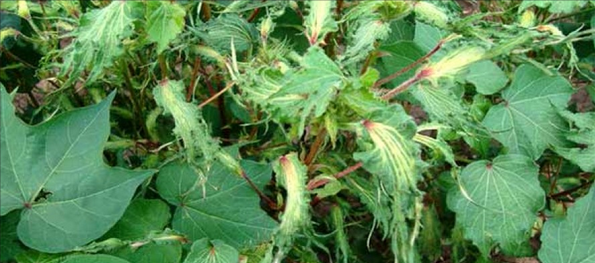An example of mid-season phenoxy herbicide damage in cotton.
Source: Oklahoma State University
By Randy Boman and Jerry Goodson
Reports of phenoxy herbicide drift damage have been noted in several counties in Oklahoma. Yield effects from this type of damage are difficult to quantify.
Yield losses are most pronounced when cotton is exposed during the squaring stage. The amount of injury is rate dependent, but any injury can cause a delay in blooming. If the maturity is delayed substantially, a significant negative impact on yield is usually observed. If this happens to an already late planted crop, it can be disastrous if an early freeze is encountered.
Many times phenoxy herbicide injury in cotton can be from a single “drift event.” If so, then the new leaves in the terminal will not show continued damage (“leaf strapping”) and fruit development may not be ruinously interrupted.
Fields that experience high single dose events or multiple sustained doses of phenoxy herbicide over time (perhaps from multiple “drift events”) may have “leaf strapping” and fruiting impact for several weeks. This can be a real yield killer.
The only thing that can be done is to manage the crop as best as possible and watch the fruit retention. This is a difficult situation, and each field (or even areas of a field) can be different based on the nature of the drift event, cotton growth stage, future growth potential (soil moisture level), etc.
Critical observations include:
- When will the oldest remaining unaffected squares potentially bloom? (what calendar date)
- What is the square retention on the plants?
- What is the last effective bloom date (calendar date) to produce a reasonably mature boll for the area
- What is the soil moisture level? (to drive yield potential)







Post a comment
Report Abusive Comment